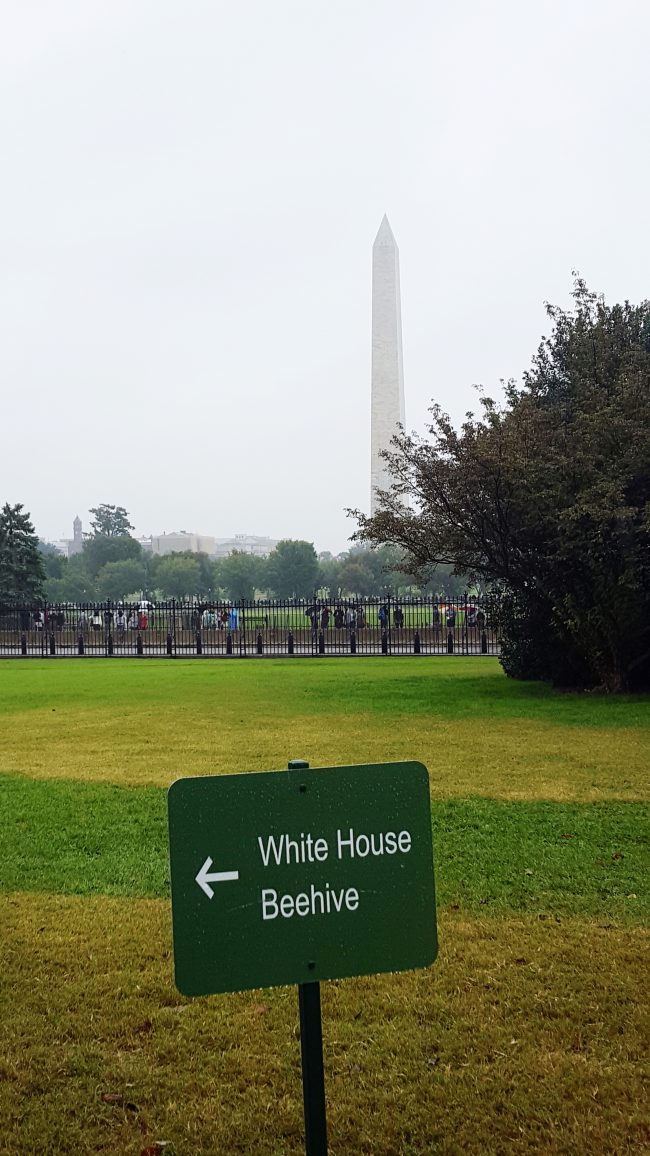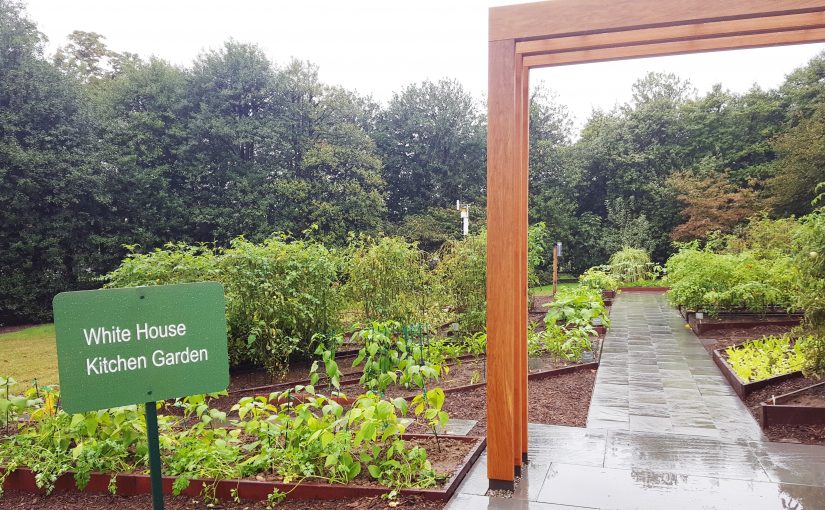I am very excited to welcome a guest here today. Linda Bilsens is the Community Composting Manager at the Institute for Local Self-Reliance and earlier this year, Michelle Obama paid a surprise visit to her garden. (I. Would. Die. – And I’d need weeks to prepare!). Linda wrote this in response to her experience and I am happy to share it with you in these final days before this election season ends. -R
On a chilly day in late-February, my husband and I received an unexpected visitor to our backyard: First Lady Michelle Obama. We are deeply honored that the First Lady chose our family’s garden (along with a couple of local schools) to act as the launchpad of her Let’s Move! Initiative. The initiative has succeeded in bringing the connection between gardening, homegrown food, and an active, healthy lifestyle into the national spotlight, and it is thought to represent the largest single impact the Obama Administration has had on food issues.
To our great surprise, the First Lady was as excited to see our compost system, which we use to recycle our food and garden scraps, as we were to show it to her. We discussed the critical role of composting in minimizing the waste our family creates and maintaining the health of our garden’s soil while the First Lady sifted our compost! After the filming ended, we continued discussing our garden, our compost, and the First Lady’s hopes for the future of the Let’s Move! Initiative. Before departing with her large entourage, as a reciprocation to her visit and as is common courtesy among gardeners, she invited us to tour her own garden at the White House.

Months later, when the growing season was in full bloom, we were hosted at the White House and were blown away with the beauty, bounty and elegance of the First Lady’s White House Kitchen Garden. What we saw were dozens of varieties of vegetables, fruits and herbs, all artfully companioned to grow in succession so that something is always ready for harvest — it is clear that a staff of skilled growers is working behind the scenes there.

During the tour, we learned that only a few days prior, the Obama Administration had hosted the leaders of the Nordic nations at a dinner on those same grounds, featuring ingredients plucked from the garden.
Nearby the Garden are the White House bees, who help pollinate the garden and provide honey to be gifted to foreign dignitaries and other distinguished guests. Of particular interest to me, of course, was the official White House composting system which makes use of the leftover organic materials from the garden and the White House’s kitchens to amend the garden’s soils. Unfortunately, the area around the compost system is off limits to visitors, so it had to be admired from afar.
 The compost created in this system is being used to take what would be waste to grow more food in a cycle as old as time and common throughout human agricultural history. This practice is also common in American political history, however, First Lady Obama’s garden is the first actively cultivated produce garden on the White House grounds since Eleanor Roosevelt’s World War II-inspired “Victory Garden.” Produce from the Garden is used not only for State dinners, but is also donated to local organizations that feed those in need. But the successes of this project and the longevity of the Garden may be in jeopardy this election year.
The compost created in this system is being used to take what would be waste to grow more food in a cycle as old as time and common throughout human agricultural history. This practice is also common in American political history, however, First Lady Obama’s garden is the first actively cultivated produce garden on the White House grounds since Eleanor Roosevelt’s World War II-inspired “Victory Garden.” Produce from the Garden is used not only for State dinners, but is also donated to local organizations that feed those in need. But the successes of this project and the longevity of the Garden may be in jeopardy this election year.

As the solar system installed by Jimmy Carter, horseshoe pit installed by George H.W. Bush, and jogging path installed by Bill Clinton before it, the White House Kitchen Garden could disappear from the grounds at the whim of an incoming President. While the First Lady has taken steps to prevent that from happening, only some stone, concrete and a few already planted spring crops stand in the way of the White House’s new residents bulldozing the Garden for another purpose.
Farming was not just an idle hobby to the founders of our nation. Instead it was a critical and patriotic pursuit that displayed both the promise of this new nation and the independence of the communities that comprised the body politic. George Washington and John Adams, our first two Presidents, retired to keep their farms after their terms in office. Thomas Jefferson, architect of the Declaration of Independence and the third President, celebrated the “yeoman” farmer as the ideal to democracy and seeds from his Monticello estate are used in the White House Kitchen Garden today. Their commitment to agriculture and the myriad gains it could contribute to our nation’s well-being and economic competitiveness cut across political divisions and, regardless of ideology, our founders raised it above their personal politics:
“1796 was a summer in which President [George Washington] discussed the culture of pineapples with the Spanish ambassador and entertained his guests with long talks on the merits of different types of ploughs, while the Vice President [John Adams] was happily mixing manure in his own yard. A keen [James] Madison oversaw the construction of a new mill in Montpelier, finding distraction from the painful defeat over the Jay Treaty. Adams was out in his fields every day, and [Thomas] Jefferson was trying his agricultural inventions at Monticello, comparing the yields of other fields. At a time when the political party lines had hardened, agriculture and its importance for the future of the United States of America remained the one topic all four agreed upon and continue to correspond about.”
Much of the latter half of the 20th century and the beginning of the 21st century have seen the increase of large-scale agriculture and a decline in family and community-scaled farms and a dis-acquaintance with composting. With concern towards food security and the growing movement for locally-sourced, wholesome food, there is no better time than now for the White House to emphasize small-scale composting and community-supported food production. The newly installed White House Kitchen Garden speaks, therefore, to an important through-line in American history and a profound new symbol of community reuse, wealth and self-reliance, all of which are vital to strengthening local economies across the country.
 In this contentious and divisive time, I would argue that the White House Kitchen Garden could also represent a positive and welcome symbol for an inclusive and collaborative path forward. Gardening and farming deserve to return to the level of respect that our often fabled Founding Fathers gave to these endeavors – with the acknowledgment that much of the labor of farming was shouldered by slaves in their time. The power of the Garden’s symbolism is only multiplied by the fact that it was founded by the Nation’s first black First Lady at a time when the number of black farmers is once again on the rise. Our need for healthy food is both fundamental and universal, it is something that unites us. We need more farmers to assure a fruitful future for our country, and we need to empower and inspire all people to contribute. I feel that the White House Kitchen Garden is a small but important step in that direction.
In this contentious and divisive time, I would argue that the White House Kitchen Garden could also represent a positive and welcome symbol for an inclusive and collaborative path forward. Gardening and farming deserve to return to the level of respect that our often fabled Founding Fathers gave to these endeavors – with the acknowledgment that much of the labor of farming was shouldered by slaves in their time. The power of the Garden’s symbolism is only multiplied by the fact that it was founded by the Nation’s first black First Lady at a time when the number of black farmers is once again on the rise. Our need for healthy food is both fundamental and universal, it is something that unites us. We need more farmers to assure a fruitful future for our country, and we need to empower and inspire all people to contribute. I feel that the White House Kitchen Garden is a small but important step in that direction.
Though Hillary Clinton, who enjoyed a small rooftop garden at the White House during her time as First Lady, has recently vowed to safeguard First Lady Obama’s garden if elected, it will be up to us to make sure it is protected under whichever candidate takes over the Oval Office. “Show me a movement,” President Obama reportedly told Dan Barber, the New York chef and writer, when discussion turned to the possibility of reforming America’s food system during his inaugural dinner. If maintaining the Garden and all it represents is something we want from the incoming President, we must show them the movement that demands it from them. Start by taking a tour of the Garden, follow the Garden on Instagram, and share this and other articles with your friends. By spreading the word, let’s make sure this inspirational new American institution has a long and useful life ahead of it.
This article was originally published at ilsr.org. Follow the Institute for Local Self-Reliance on Twitter and Facebook for timely updates.
Wow, what a wonderful tour. Love that compost bin and those gardens are beatiful.
DaveP